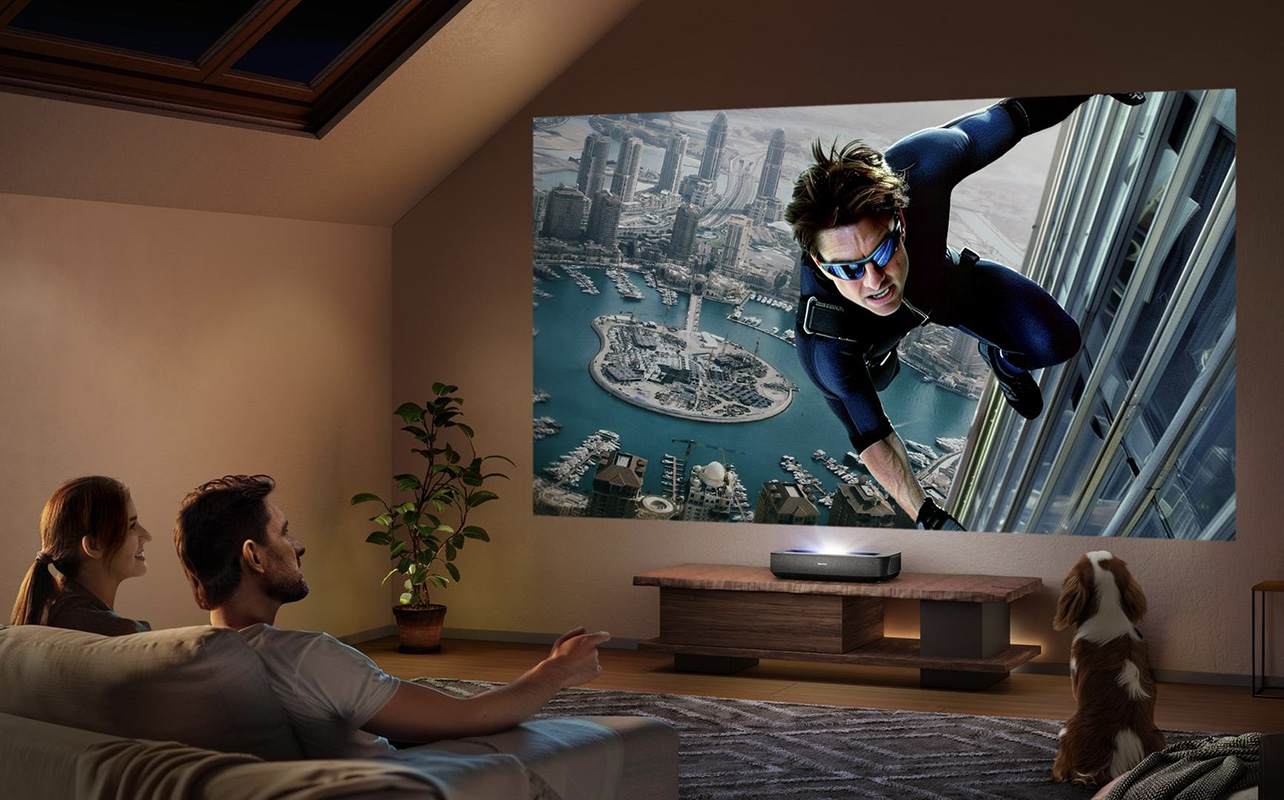
Not long ago, the world of projectors was dominated by bulky, dim machines with short-lived bulbs and long warm-up times. For classrooms, boardrooms, or movie nights at home, traditional lamp-based projectors did the job, but not without their quirks. Fast-forward to today, and laser projectors have completely changed the game.
Laser projectors are quickly becoming the go-to choice for both home entertainment buffs and professionals, alike. Their sleek designs, bright and crisp images, and low-maintenance operation make them an attractive option across the board.In this guide, we’ll explore what laser projectors are, how they work, how they differ from traditional models, and if one might be right for you. Whether you’re shopping for your first projector or just curious about the latest tech, we’ve got you covered.
What is a laser projector?
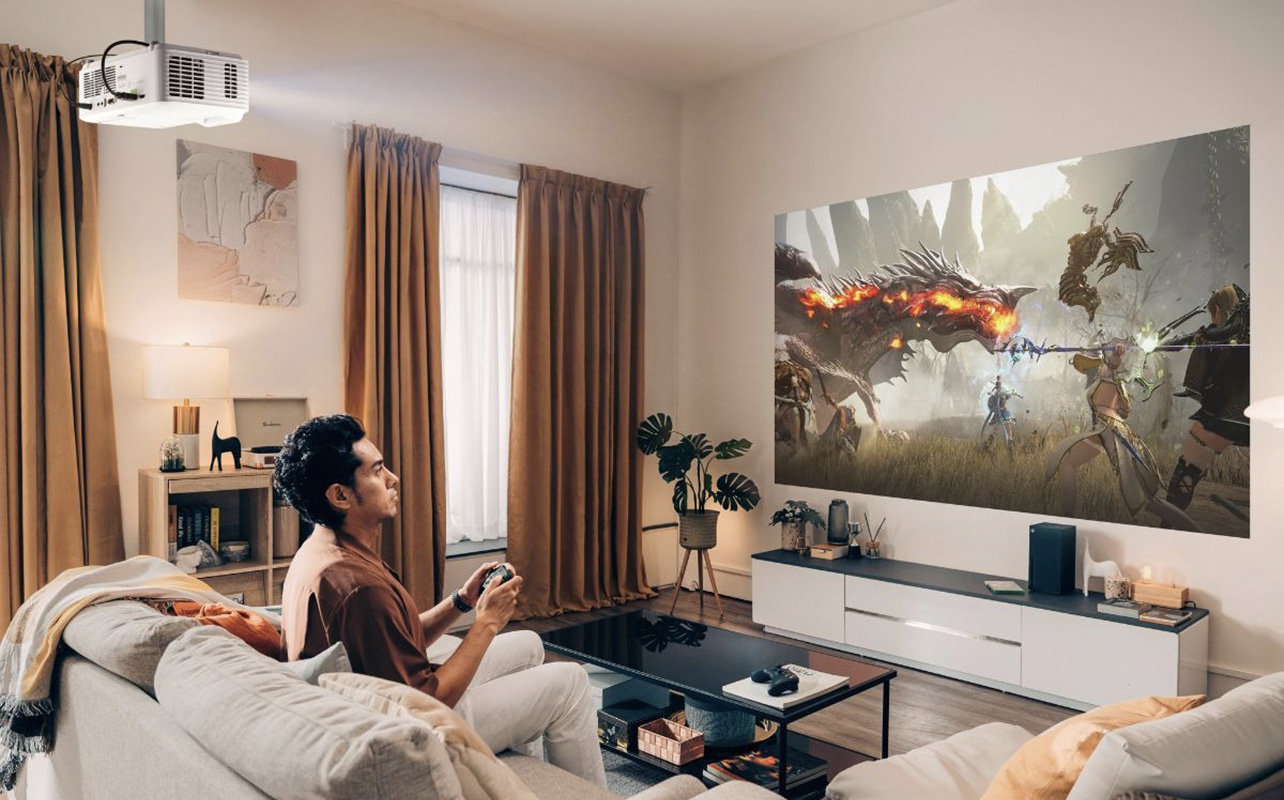
Let’s start with the basics: what is a laser projector? A laser projector is a type of projector that uses laser light as its primary source of illumination instead of a traditional lamp or LED. This laser light is directed through a series of optics and mirrors, which then project an image onto a screen.
Unlike traditional lamp-based projectors that rely on bulbs that fade over time, laser projectors offer consistent brightness and colour over a much longer lifespan. They’re also faster to start up, quieter, and generally more reliable.
Key components of a laser projector
- Laser light source: Instead of a bulb, lasers produce the image’s light. These can be red, green, and blue lasers (RGB) or a blue laser combined with phosphors to create white light.
- Mirrors and optics: These components guide and shape the laser beams to form images.
- Projection system: This converts the light into video signals and projects the final image onto a surface.
What is the difference between a standard projector and a laser projector?
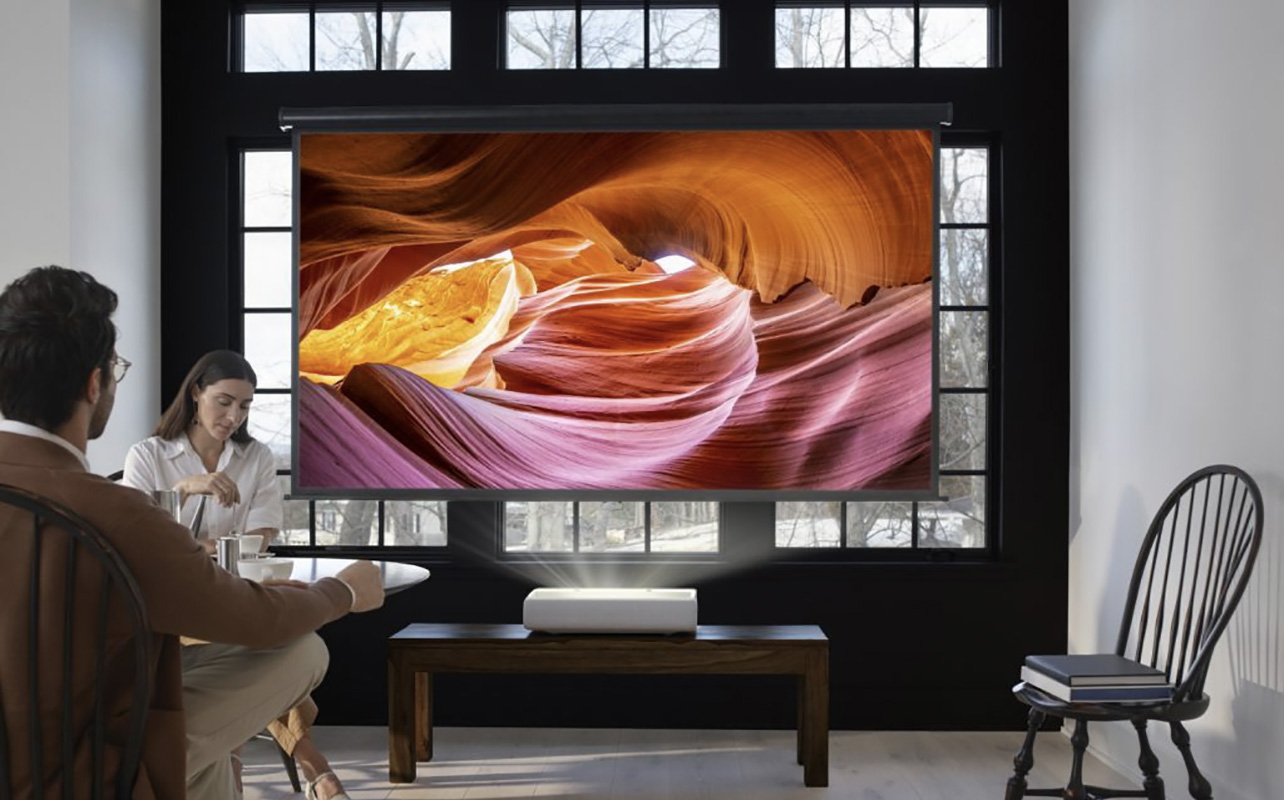
This is one of the most common questions people ask when shopping. The main difference comes down to the light source. Traditional projectors use lamps (bulbs) or LEDs to generate light. These bulbs need replacing every few thousand hours. Laser projectors use laser diodes, which can last 20,000 hours or more and offer greater consistency in image quality.
Here is a quick comparison between standard and laser projectors.
| Feature | Lamp-based projector | Laser projector |
| Light Source | Halogen/metal-halide lamp | Laser diodes |
| Brightness Over Time | Diminishes | Consistent |
| Warm-Up Time | Several minutes | Instant on/off |
| Maintenance | Frequent bulb replacement | Minimal maintenance |
| Lifespan | 2,000–5,000 hours | 20,000+ hours |
| Energy Efficiency | Lower | Higher |
For a deeper dive, check out our article about the difference between lamp projectors and laser projectors.
How do laser projectors work?
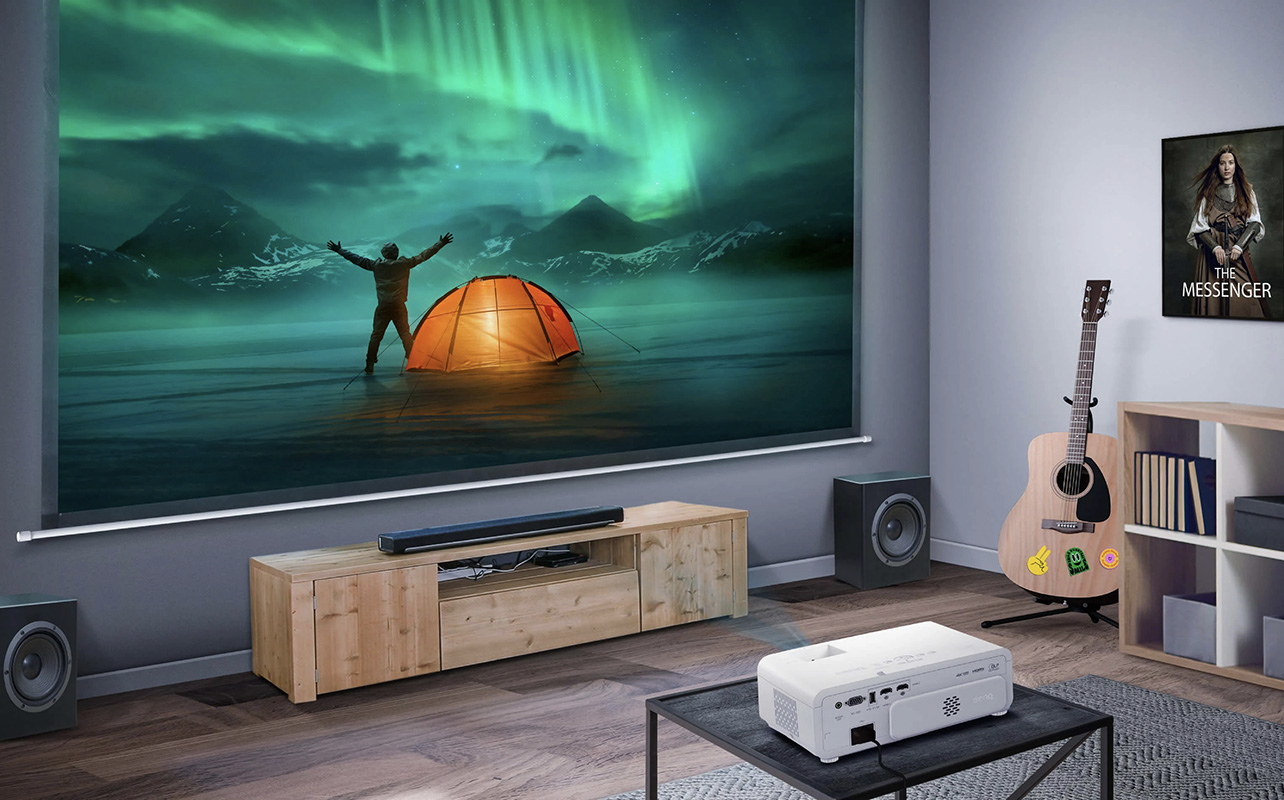
Laser projectors might sound like something out of a sci-fi movie, but their inner workings are pretty fascinating and surprisingly straightforward.
A laser projector uses laser beams to generate light. Depending on the model, it may use separate red, green, and blue (RGB) lasers or a blue laser combined with a phosphor wheel that emits white light. These beams are then bounced through a series of mirrors and lenses that guide them into a digital imaging chip (like DLP or LCD), which shapes the light into the images you see.
RGB lasers allow for a wider colour gamut, giving laser projectors a huge edge in colour accuracy. There’s also no dimming over time. Lasers maintain their intensity far better than lamps, so your image stays sharp and bright, year after year.
Benefits of laser projectors

So why is everyone raving about laser projectors? Here are some of the standout benefits:
1. Superior brightness and colour accuracy: Laser projectors deliver vibrant colours and strong contrast, even in well-lit rooms. This makes them ideal for both home theatres and bright office environments.
2. Longer lifespan: One of the biggest perks of laser projectors is that they don’t require bulb replacements. Unlike traditional models that rely on lamps that degrade and need replacing every few thousand hours, lasers maintain their performance much longer. Most laser projectors offer lifespans of 20,000 to 30,000 hours, sometimes even more. That translates into serious savings on maintenance and fewer interruptions.With a lifespan of 20,000+ hours, laser projectors easily outlast lamp-based counterparts. To put that in perspective, it could equate to over 10 years of watching a two-hour movie every single day.
3. Low maintenance: There are no bulbs to replace with laser projectors, nor worries about brightness fading. That means less hassle and fewer trips to the repair shop.
4. Energy efficient and instant on/off: Laser projectors consume less power and don’t need to warm up. Just press the power button and you’re ready to roll.
What are the disadvantages of laser projectors?
While laser projectors are packed with advantages, they’re not perfect for everyone. Here are some of their main downsides.
1. Higher upfront cost: Laser projectors typically cost more than lamp-based models. But when you factor in the longer lifespan and lower maintenance, they can offer better long-term value.
2. Limited budget options: If you’re a casual user looking for something under $500, your options may be limited with laser models.
3. Fan noise or heat in compact units: Some portable or compact laser projectors can generate heat and require active cooling, which might produce noticeable fan noise.
4. Uniformity issues in lower-end models: Budget-friendly laser projectors might show slight inconsistencies in brightness or colour across the screen.
Types of laser projectors

Not all laser projectors are created equal. Depending on how you plan to use it, here are the main types to consider:
1. Home theatre projectors: These are designed for cinema-quality experiences. They often support 4K resolution, deep blacks, and vivid colours.
2. Portable laser projectors: Compact and lightweight, they are perfect for travel, presentations, or casual viewing. Some models even come with built-in batteries.
3. Ultra short throw (UST) projectors: These sit just inches from the wall or screen and still produce a large image. They are great for small rooms or sleek home setups.
4. Professional and industrial projectors: Used in large venues, museums, stadiums, or simulation setups, these beasts are built for high output, 24/7 use, and robust durability.
When should you choose a laser projector?
Not sure if a laser projector is right for you? They make the most sense if you need high brightness and vibrant colours, especially in rooms with lots of ambient light. If you think you’ll use your projector frequently and want something low-maintenance, they are a good choice. Laser projectors are perfect for home theatre enthusiasts who values stunning visuals and wants that “instant-on” movie night. You may also find laser projectors worthwhile if you run a business or school and need reliable tech that won’t break down mid-presentation. Finally, they are great for future-proofing your setup with a modern, energy-efficient device.
Choosing the right laser projector
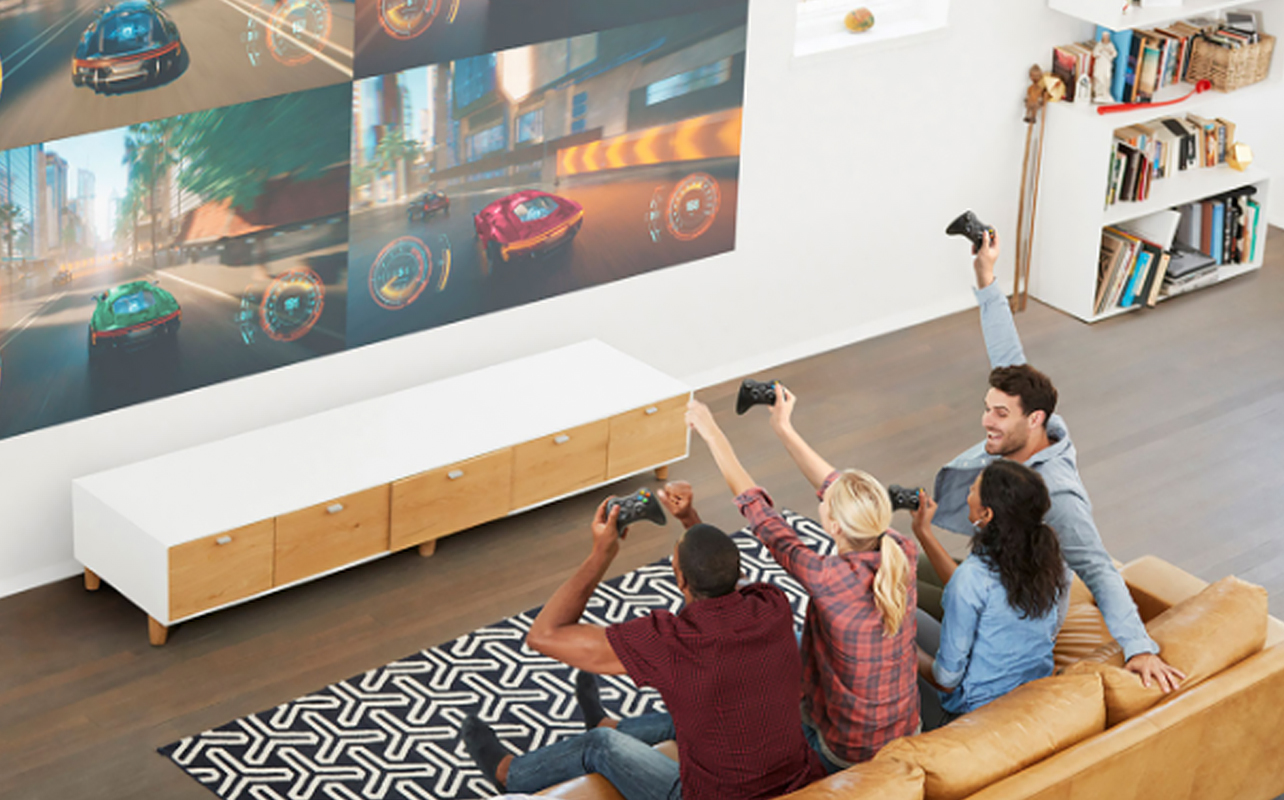
There’s a checklist of things you can run through in order to help you choose the right laser projector.
Room size and light levels: Bright rooms need higher lumen output. If you’re setting it up in a small, dark room, a mid-range model should do. Also consider how the projector screen dimensions fit into the room and space you have planned for it. It’s crucial to choose one with the right dimensions, throw distance, and more.
Use case: Which one you choose might depend on what you plan to watch most often. If you’re looking for a laser projector for mostly watching movies and playing games, seelct a 4K model with HDR and low input lag. If it’s more so for presentations, prioritize brightness and portability.
Resolution: The best resolution for immersive viewing and to future-proof your investment is a 4K projector. 1080p is great for casual viewing, especially if you don’t subscribe to 4K streaming services, cable/satellite TV, or have a Blu-ray player. But even then, a 4K projector may yield a better image and it’s worth the extra few bucks.
Connectivity: Make sure it supports HDMI, USB, Wi-Fi, Bluetooth, or any other ports/devices you plan to use. This will allow you to connect all types of source devices, from a gaming console to a streaming stick, or even mirror from your phone, tablet, or computer if the projector supports that.
Budget: Laser projectors start around $800–$1,000 for basic models, with high-end units running upwards of $3,000 or more. While this might sound like a lot upfront, consider the long-term savings when comparing them with cheaper lamp-based units.
The future of projection is laser—are you in?
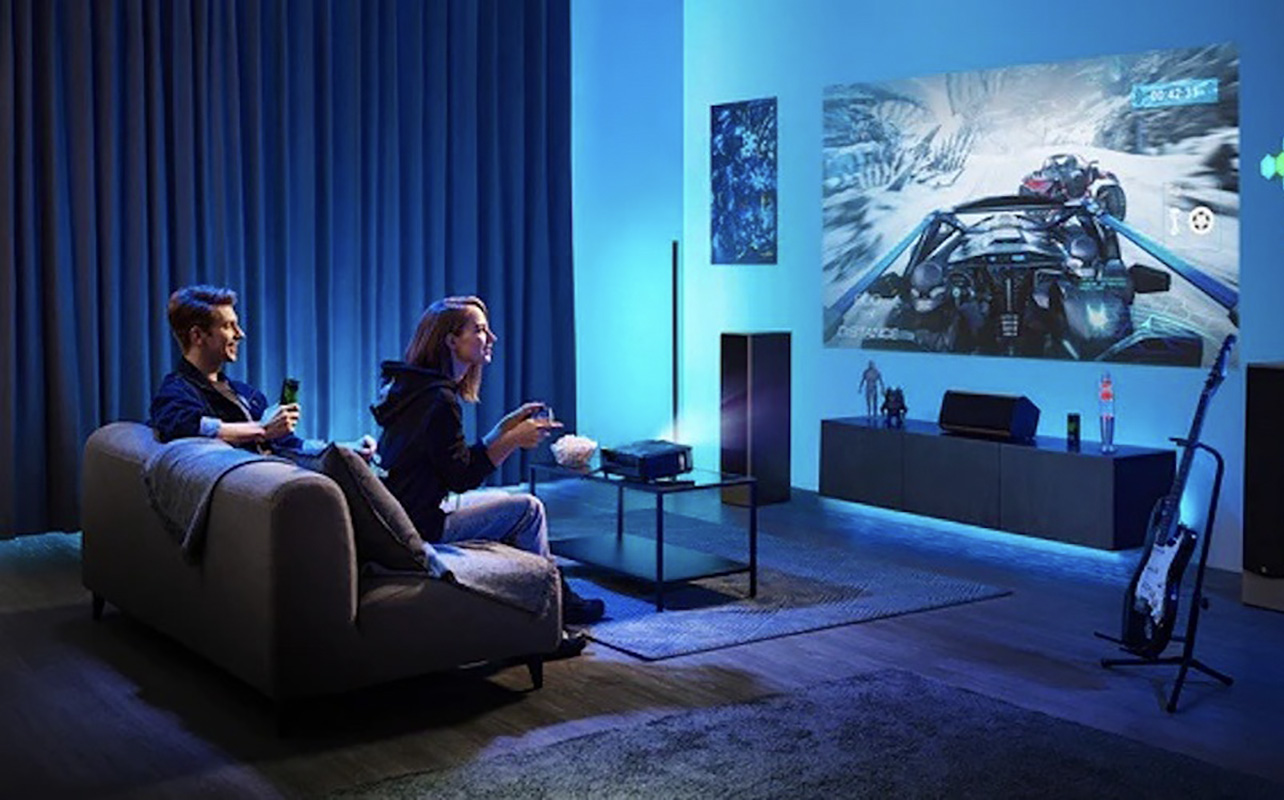
Laser projectors are reshaping how we experience visual content. Whether it’s a movie night, a work presentation, or an epic gaming session, they offer a big screen experience like no other. With their unbeatable image quality, longevity, and ease of use, they’re a smart investment for just about any setup. So, if you’re tired of changing bulbs or squinting at dull images, it might be time to make the switch.
Ready to dive in? Learn everything you need to know about projectors in our projector buying guide. Then, explore Best Buy Canada’s laser projector selection and find the one that fits your space, style, and budget.





